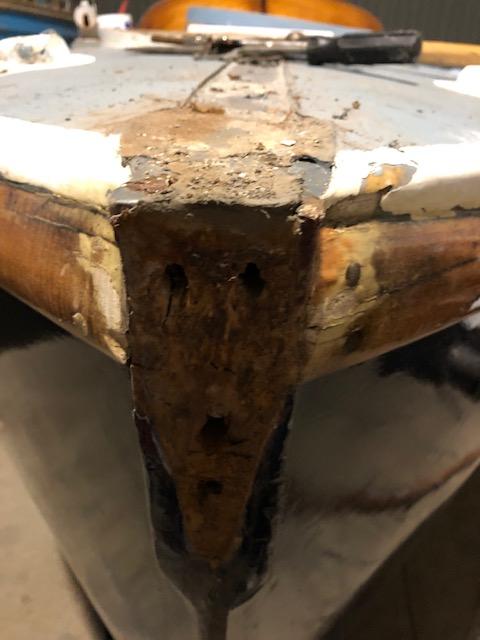- This topic has 3 replies, 3 voices, and was last updated 3 years, 1 month ago by .
- Topic
A question to the wise men…
Yesterday I took the chain-plates and bow roller off Mary and in general she is in good condition. I believe the bolts were galvanised probably hardware shop issue and sparing on zinc. I see a bit of the price tag is on one.

However, they were quite difficult to remove and not all they used to be. This is fine they will be replaced. My question relates to the bit I won’t replace, and how to make bolts removal easier in future? The ethos of the question is iron rots wood zinc doesn’t. Is that correct?

The two lower holes vertically aligned are through bolts, The two rusty bolts above. The two upper holes were fixing screws which are unlikely to have had much of a structural impact. These looked like bronze screws (bonus question) which I believe is very bad on a galvanised fitting. Hence it ate all of the wood in contact with the screws and the screws had bonded to the metalwork. There was no chance of just pulling the screws out. These need replacing with galvanised or stainless screws, correct?
So to make this easier in future I wish to drill out and dowel the upper holes. But the lower holes I believe the best solution is to line the holes with resin, basically fill them and drill them out again? There is only one chain plate bolt hole that looks like it could do with some wood letting back in. But this may not be necessary.
Generally when refitting the galvanised bolts, here and on the chain-plates I think I need some form of goop. This is used to fill the air void and avoid decay? Most bolt holes are not too bad and a suitable ‘goop’ would do the job. I am thinking of a heavy grease, one that won’t get absorbed totally into the wood. I don’t think the answer is mastic or sikoflex. I don’t like pulling bolts out that have been glued in with mastic.
It is my preference to seal the wood, paint it, before bolting the fittings on. Maybe paint the fittings separately. Should I use a tar-paper or similar between the fitting and the hull?
Also where to buy replacement bolts with a reasonable amount of zinc on them? Or should I get a job-lot hot dipped? Including re-galvanising the fittings.
- You must be logged in to reply to this topic.


